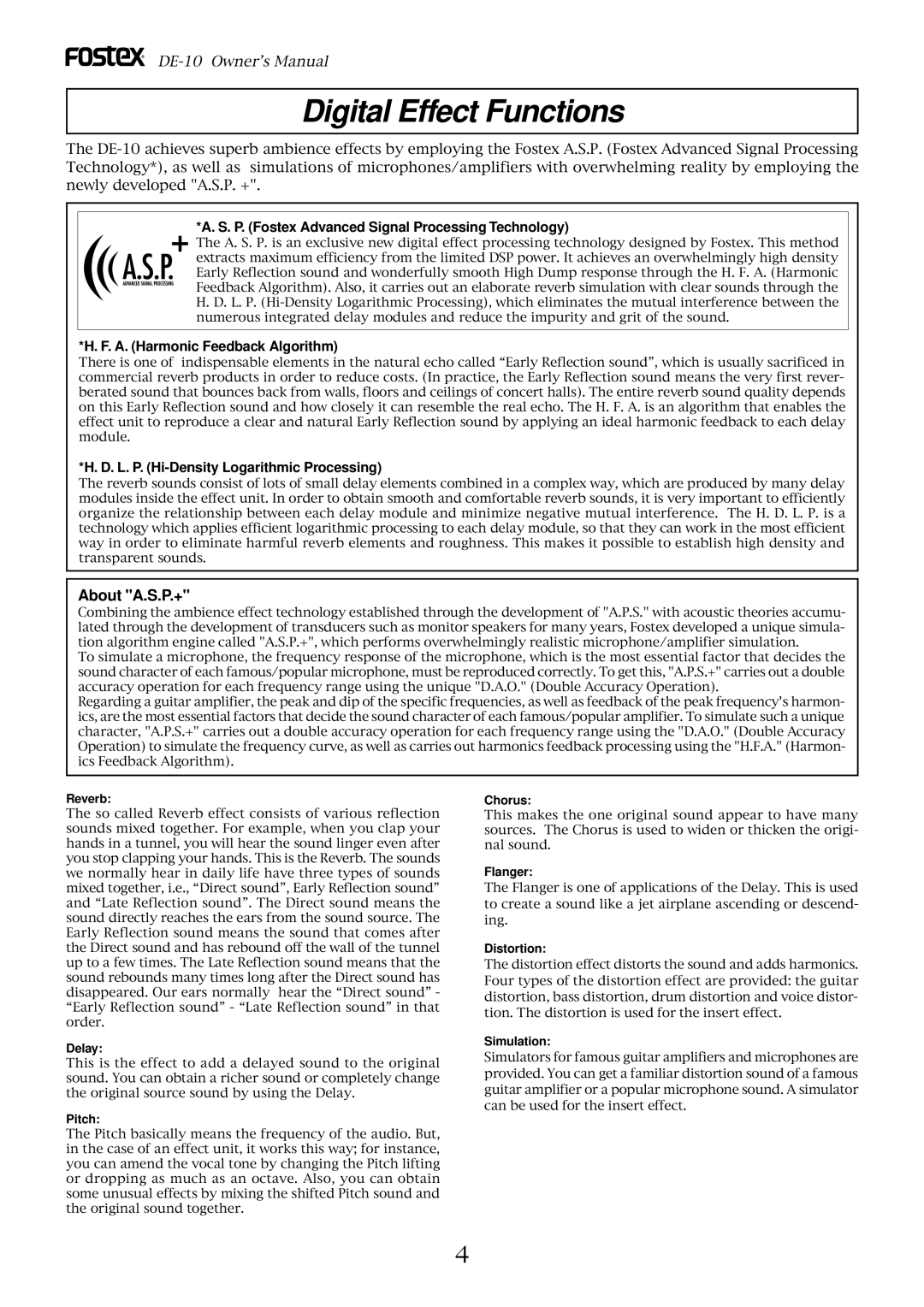
Digital Effect Functions
The
*A. S. P. (Fostex Advanced Signal Processing Technology)
The A. S. P. is an exclusive new digital effect processing technology designed by Fostex. This method extracts maximum efficiency from the limited DSP power. It achieves an overwhelmingly high density Early Reflection sound and wonderfully smooth High Dump response through the H. F. A. (Harmonic Feedback Algorithm). Also, it carries out an elaborate reverb simulation with clear sounds through the H. D. L. P.
*H. F. A. (Harmonic Feedback Algorithm)
There is one of indispensable elements in the natural echo called “Early Reflection sound”, which is usually sacrificed in commercial reverb products in order to reduce costs. (In practice, the Early Reflection sound means the very first rever- berated sound that bounces back from walls, floors and ceilings of concert halls). The entire reverb sound quality depends on this Early Reflection sound and how closely it can resemble the real echo. The H. F. A. is an algorithm that enables the effect unit to reproduce a clear and natural Early Reflection sound by applying an ideal harmonic feedback to each delay module.
*H. D. L. P. (Hi-Density Logarithmic Processing)
The reverb sounds consist of lots of small delay elements combined in a complex way, which are produced by many delay modules inside the effect unit. In order to obtain smooth and comfortable reverb sounds, it is very important to efficiently organize the relationship between each delay module and minimize negative mutual interference. The H. D. L. P. is a technology which applies efficient logarithmic processing to each delay module, so that they can work in the most efficient way in order to eliminate harmful reverb elements and roughness. This makes it possible to establish high density and transparent sounds.
About "A.S.P.+"
Combining the ambience effect technology established through the development of "A.P.S." with acoustic theories accumu- lated through the development of transducers such as monitor speakers for many years, Fostex developed a unique simula- tion algorithm engine called "A.S.P.+", which performs overwhelmingly realistic microphone/amplifier simulation.
To simulate a microphone, the frequency response of the microphone, which is the most essential factor that decides the sound character of each famous/popular microphone, must be reproduced correctly. To get this, "A.P.S.+" carries out a double accuracy operation for each frequency range using the unique "D.A.O." (Double Accuracy Operation).
Regarding a guitar amplifier, the peak and dip of the specific frequencies, as well as feedback of the peak frequency's harmon- ics, are the most essential factors that decide the sound character of each famous/popular amplifier. To simulate such a unique character, "A.P.S.+" carries out a double accuracy operation for each frequency range using the "D.A.O." (Double Accuracy Operation) to simulate the frequency curve, as well as carries out harmonics feedback processing using the "H.F.A." (Harmon- ics Feedback Algorithm).
Reverb:
The so called Reverb effect consists of various reflection sounds mixed together. For example, when you clap your hands in a tunnel, you will hear the sound linger even after you stop clapping your hands. This is the Reverb. The sounds we normally hear in daily life have three types of sounds mixed together, i.e., “Direct sound”, Early Reflection sound” and “Late Reflection sound”. The Direct sound means the sound directly reaches the ears from the sound source. The Early Reflection sound means the sound that comes after the Direct sound and has rebound off the wall of the tunnel up to a few times. The Late Reflection sound means that the sound rebounds many times long after the Direct sound has disappeared. Our ears normally hear the “Direct sound” - “Early Reflection sound” - “Late Reflection sound” in that order.
Delay:
This is the effect to add a delayed sound to the original sound. You can obtain a richer sound or completely change the original source sound by using the Delay.
Pitch:
The Pitch basically means the frequency of the audio. But, in the case of an effect unit, it works this way; for instance, you can amend the vocal tone by changing the Pitch lifting or dropping as much as an octave. Also, you can obtain some unusual effects by mixing the shifted Pitch sound and the original sound together.
Chorus:
This makes the one original sound appear to have many sources. The Chorus is used to widen or thicken the origi- nal sound.
Flanger:
The Flanger is one of applications of the Delay. This is used to create a sound like a jet airplane ascending or descend- ing.
Distortion:
The distortion effect distorts the sound and adds harmonics. Four types of the distortion effect are provided: the guitar distortion, bass distortion, drum distortion and voice distor- tion. The distortion is used for the insert effect.
Simulation:
Simulators for famous guitar amplifiers and microphones are provided. You can get a familiar distortion sound of a famous guitar amplifier or a popular microphone sound. A simulator can be used for the insert effect.
4
